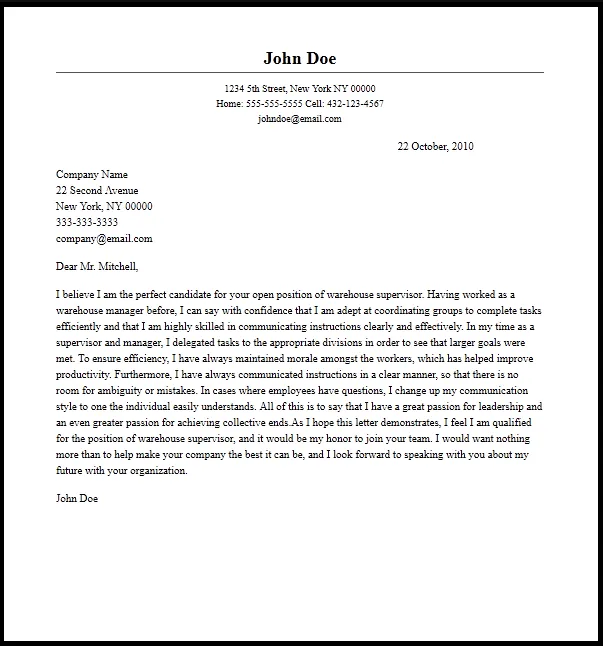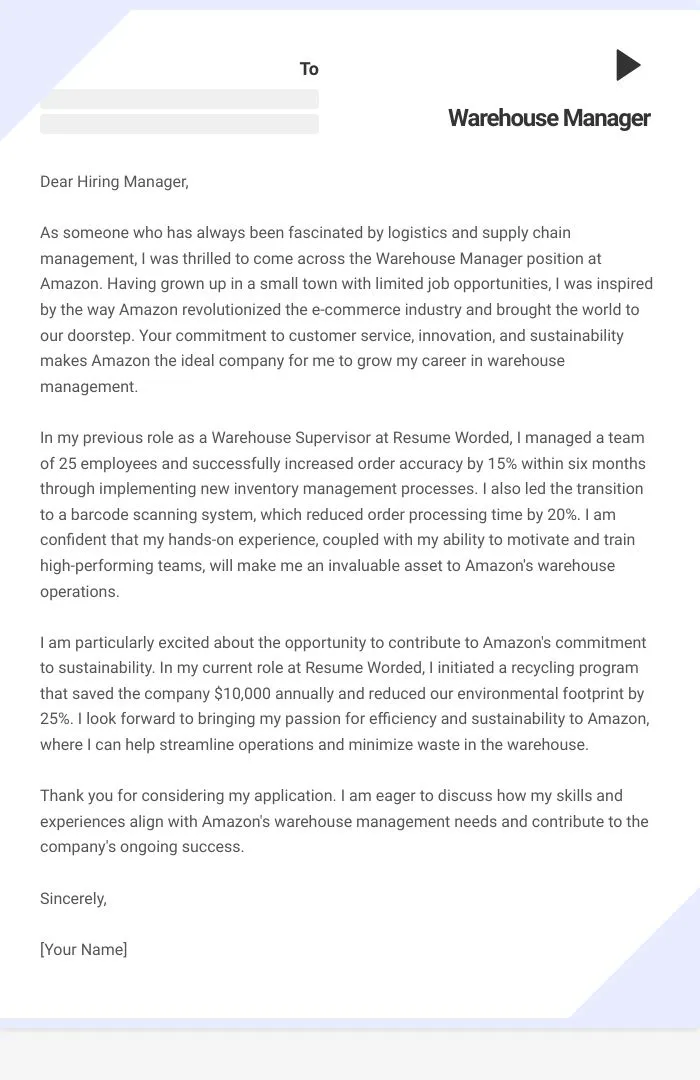Crafting a Powerful Warehouse Manager Cover Letter
A well-crafted cover letter is your first opportunity to make a strong impression on a potential employer. It’s your chance to showcase your skills, experience, and enthusiasm for the warehouse manager position. Unlike a resume, which is a factual summary of your career, a cover letter allows you to tell your story and explain why you are the ideal candidate. It should be concise, engaging, and tailored to the specific job and company. Remember, your cover letter is not just a formality; it is a critical tool in getting your foot in the door and securing an interview. A strong cover letter should highlight your relevant skills and accomplishments, demonstrating how you can contribute to the company’s success. Always ensure your cover letter complements your resume and provides additional context to your application.
Highlighting Your Warehouse Experience
Your warehouse experience is the cornerstone of your application. Your cover letter needs to provide a vivid picture of your experience. Focus on your key responsibilities and the successes you’ve achieved in those roles. Detail your experience with inventory management, order fulfillment, shipping and receiving, and warehouse safety protocols. Mention the size of warehouses you have managed, the types of goods you have handled, and any specialized equipment or technologies you are proficient with, such as warehouse management systems (WMS). By providing specific examples, you provide concrete evidence of your capabilities. For example, instead of saying “Managed warehouse operations,” you might state, “Successfully managed a 50,000 sq ft warehouse, overseeing a team of 20 employees and processing over 500 orders daily.” Highlighting your experience builds trust with the hiring manager and shows you understand the complexities of the job.
Demonstrating Inventory Management Skills

Inventory management is a vital aspect of a warehouse manager’s role. Highlight your skills in this area by mentioning specific inventory control methods you’ve used, such as FIFO (First-In, First-Out), LIFO (Last-In, First-Out), or just-in-time inventory. Describe your experience with cycle counts, physical inventories, and reconciliation processes. Mention any software or systems you’ve used to manage inventory, such as SAP, Oracle, or specialized WMS software. Emphasize your ability to minimize inventory shrinkage, reduce carrying costs, and improve order accuracy. For instance, you could write “Implemented a new inventory tracking system that reduced inventory discrepancies by 15%.” Show that you are proficient in data analysis and reporting, demonstrating how you use data to optimize inventory levels and improve warehouse efficiency. This demonstrates that you have the skills needed to manage this key aspect of the business.
Showcasing Leadership and Team Management
Warehouse management is not just about managing inventory and processes; it’s about leading and motivating a team. In your cover letter, emphasize your leadership qualities, your ability to motivate and train employees, and your experience fostering a positive work environment. Describe your communication style and your approach to conflict resolution. Provide examples of how you have successfully led and developed teams, such as through mentoring, training programs, or performance reviews. Mention your experience with employee scheduling, performance management, and disciplinary actions if applicable. The ability to inspire and lead a team is crucial for success in a warehouse environment, so illustrate the impact you’ve had in previous roles, like increased productivity, improved employee satisfaction, or reduced turnover rates. Employers need to see that you can manage the workforce effectively.
Quantifying Achievements in Your Cover Letter
Instead of simply listing your responsibilities, use numbers and data to quantify your achievements. This makes your cover letter more compelling and demonstrates the tangible results you have achieved. For example, instead of saying “Improved warehouse efficiency,” you could write “Improved warehouse efficiency by 20% through the implementation of new process.” Use metrics like reduced order processing time, decreased shipping costs, or improved accuracy rates to highlight your accomplishments. If you have experience with safety programs, mention any reductions in workplace accidents or improvements in compliance. Including specific figures and data will make your cover letter stand out from the competition and show the hiring manager the value you can bring to their organization. Quantifiable achievements provide concrete evidence of your capabilities and leadership.
Using Action Verbs to Impress

Action verbs are your secret weapon for making your cover letter more dynamic and engaging. They help you to communicate your accomplishments in a powerful and memorable way. Instead of using passive language, use active verbs to describe what you did in your previous roles. Some examples of action verbs include “managed,” “led,” “implemented,” “optimized,” “increased,” “reduced,” “achieved,” “developed,” and “streamlined.” For instance, instead of writing “Responsible for inventory control,” you could write “Managed inventory control, reducing discrepancies by 10%.” Using strong action verbs demonstrates your capabilities and makes your cover letter more appealing to the hiring manager. This helps keep your cover letter engaging and highlight your key skills.
Tailoring Your Cover Letter to the Job
A generic cover letter is unlikely to make a strong impression. To stand out, you need to tailor your cover letter to each specific job you apply for. Carefully read the job description and identify the key skills and requirements the employer is looking for. Then, in your cover letter, highlight your experience and accomplishments that are most relevant to those requirements. Show how your skills and experience align with the specific needs of the position and the company. Research the company and demonstrate your understanding of their business and culture. Showing that you have taken the time to personalize your cover letter will demonstrate your genuine interest in the position and increase your chances of getting an interview. Tailoring also means using the same keywords and phrases that are used in the job posting.
Proofreading and Formatting Your Cover Letter
Before you submit your cover letter, proofread it carefully to catch any errors in grammar, spelling, or punctuation. These errors can detract from your professionalism and damage your chances of getting an interview. Use a spell checker, but also read through the letter yourself, as spell checkers can sometimes miss errors. Consider having a friend or colleague review your cover letter for you, as a fresh pair of eyes can often spot mistakes that you might miss. In terms of formatting, use a professional and easy-to-read font, such as Times New Roman, Arial, or Calibri. Keep your cover letter concise – ideally, no more than one page. Use clear headings and bullet points to break up the text and make it easier to read. Proper formatting and attention to detail are essential for presenting a polished and professional image.
